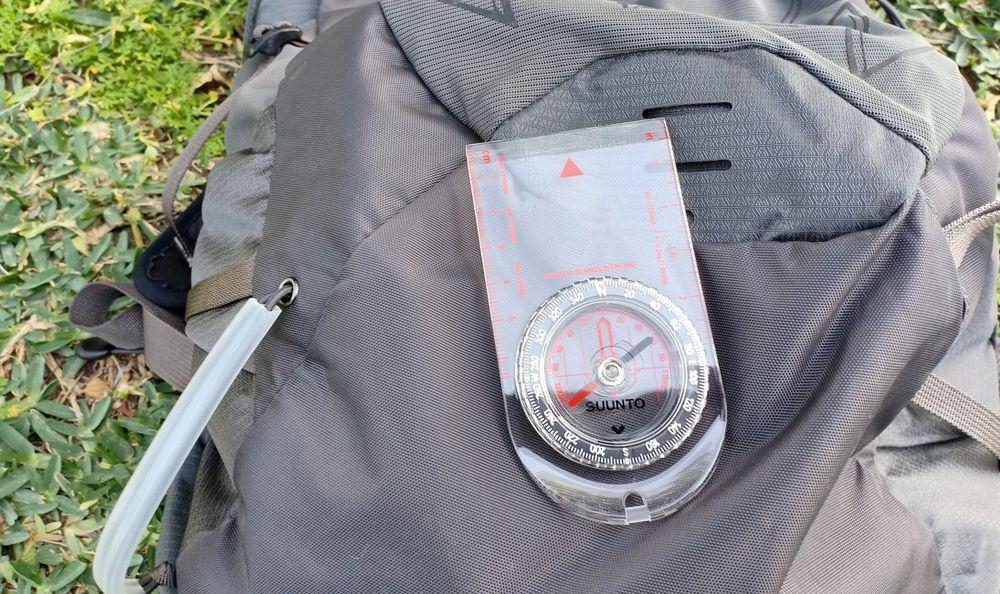Far from the online hustle, GPS is a device that makes sure that hikers find the right direction and reach the destination. We have navigated through plains, deserts, rough terrains, dense forests, mountains, and gullies with a navigation compass mostly offline. Our experience with Compass exceeds 20 years. Based on this experience, we can tell you that a reliable compass will never lead you astray. Hiking and adventuring becomes a lot easier if we choose the right gear. In this article, we will review all the compasses that we used and will guide you to the right compass for beginners and the one for professionals.
Let’s talk about some highly professional compasses and some lighter versions to compare and contrast for your ease.
Best Overall Compass
SUUNTO MC-2 Compass
SUUNTO is famous for compasses, and it offers countless choices to the hikers. The SUUNOTO MC-2 is a standout option for the professionals and hikers. It includes all the features that a hiker needs. While I took this compass many times for hiking in different geographic locations, I found it durable, reliable, handy, and precise.

First of all, it has a global needle system, which enables the hiker to be care-free of latitudes. Some compasses are region-specific, but you can use the SUUNTO MC-2 globally, making it best suited for international adventures.
Secondly, the mirrored baseplate helps in precision. Users can correct the magnetic variation through the adjustable declination. It also includes a clinometer to measure slopes. It helps assess the terrain steepness and reduce the avalanche risk.
Its waterproof construction and scratch-resistant sapphire crystal make it ideal for rough use. It has luminous markings on its digits, which allow the user to read it even in the dark. I liked this feature so much. Finally, the thumb loop helped in stability during navigation.
Considering the seamless integration and unmatched reliability, the high price is justifiable. I have used it multiple times, and I can recommend it for professional hikes.
Best Budget Friendly Compass
SUUNTO A-10 Compass
One of the simplest yet most effective compasses on a cheaper price tag is the SUUNTO A-10. Hikers who seek simplicity without sacrificing important features in a compass, SUUNTO A-10 offers it with perfection.

This lightweight model has a clearly defined baseplate with markings for map scaling. It also has a rotating bezel for accuracy and precision. For stabilization, this compass has a liquid-filled capsule that offers stability to the needle even in rough terrains.
To make it user-friendly, A-10 offers luminous markings for low-light navigation and understanding. For rainy conditions, it offers a non-slip grip. It does not have adjustable declination, which some of the higher-end compasses offer. Adding to it, this compass is durable and affordable for hikers. It can slip into a pocket, and also you can attach it to your gear through an adjustable hook, adding yet another property of portability.
With all the features, the compass becomes a perfect choice for the hikers and backpackers who have just started their careers. Its no-frills functionality makes it a trusted backup for hikers. It lacks a precise clinometer, which makes it a bit old-fashioned for the mountainous areas. However, with basic necessities, it is a straightforward and dependable tool for normal navigation.
Read More: SUUNTO A-10 Compass Review
Best for Kids
Coghlan’s Function Whistle
Coghlan’s whistle is one of the basic tools that offer simplicity, multipurpose, and style at the same time. It is basically a multi-tool that offers a whistle, a compass, a thermometer, and a signal mirror.

For beginners, it is lightweight and small, offering all the basic requirements of navigation and emergency signaling. The whistle is for emergency signaling. The mirror is a high-end alternative to whistles for the same purpose.
The compass provides a basic understanding of the directions. For weather awareness, the thermometer aptly helps the user. It may not be as effective as professional devices, but it works aptly as a survival kit.
While it is helpful, you can attach it to your backpack with its hook. Its lightweight and portability offer unbelievable value to the hikers. Lastly, its price value is also affordable, which makes it a reliable choice for the hikers.
Read More: Coghlan’s Four Function Whistle Review
Best of the Rest
TurnOnSport Orienteering Compass
Orienteering is a sport in which runners have to find their way across rough country with the aid of a map and compass.
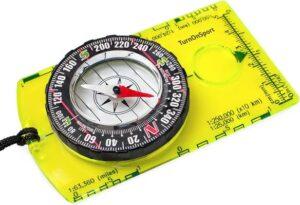
Normally used by scouts, this compass offers an exciting functionality on a price tag as low as $12. I have been to various places in life for hiking. When I used the TurnOnSport orienteering compass, I felt relieved from a burden.
Firstly, it offers a durable acrylic baseplate, an adjustable bearing, a magnifying glass, a compass ruler, and a 1:24,000 for precise route mapping. For beginners, I recommend TurnOnSport compass as a simple and inexpensive option on which you can learn the basics.
Ranger 2.0 Compass
Another excellent choice for the hikers is the Ranger 2.0 compass. It excels in precision with a sighting mirror for accuracy. Its global needle allows you to use it around the globe, and the declination scale offers a wonderful aid in quick adjustments.
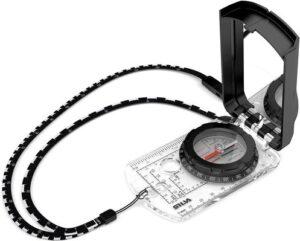
It is a waterproof compass, and it has a metal bezel, which adds to its durability. It has a flawless accuracy. Secondly, owing to its precision, you can use this device as a military-grade compass. Considering its uses, you can rely on this compass for accuracy and rain. Users prefer this compass for fast races, running sessions, long run-commuting, and multi-day running sessions.
Buying Guide: How to Choose Compass
Types of Compasses
You can choose the best compasses only by knowing compass types. It will allow you to precisely ask for a specific model or shape of compasses.
Firstly, baseplate compasses are lightweight and have a clear baseplate. It makes them excellent for map reading. E.g., Silva Ranger Global, Brunton Truarc3, Suunto A-30, and Silva Classic Compass.
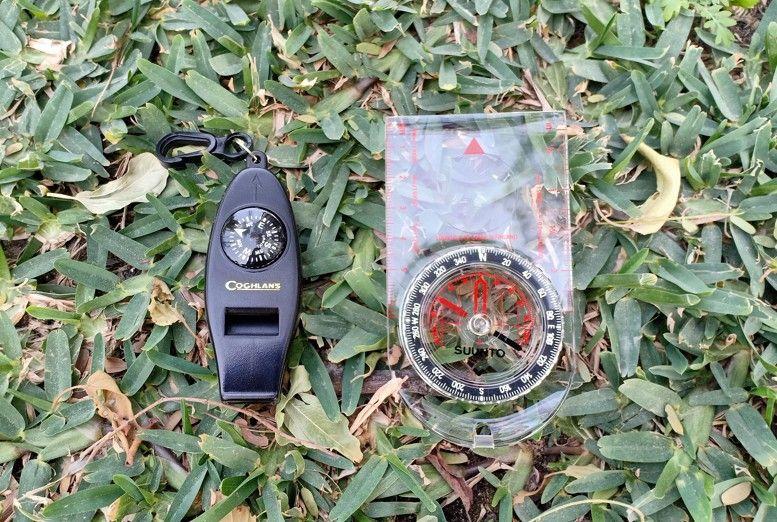
Secondly, you can use lensatic compasses in military settings. It is a magnetic compass with a magnifying lens for accuracy. E.g., Cammenga Official US Military Tritium Lensatic Compass and the Coghlan’s Lensatic Compass.
Furthermore, thumb compasses are special orienteering compasses that you can align to your thumb for map reading. These compasses are for orienteering to save time. E.g., Silva Arc Jet OMC, Williams Fellmaster Compass, Suunto Norcompass.
Lastly, there are mirrored compasses for enhanced accuracy over long distances. E.g., Suunto MC-2, Silva Ranger 2.0, and Stanley London Mirror Sighting Map Compass.
Overall, baseplate models suit best for general hiking, while mirrored ones are beneficial for technical terrains.
Key Features of a Compass
Compasses have specific features. Only expert hikers distinguish and aptly decide the right use of a compass. There are certain features that I discovered to be very helpful in understanding a compass and its fair use.
Firstly, compasses have a global needle, which defines the areas in which the compass will work based on the alignment of the compass with the latitudes. Some compasses work for a specific hemisphere while others work globally. The latter are a right choice if you are a professional hiker and plan to go on a world tour.

Secondly, the declination adjustment feature helps correct the map-to-field bearings. Hikers use the clinometer of a compass for understanding the slope of the terrain. It is a useful feature for hiking in mountainous areas.
Adding to it, compasses have luminous readings, which allow a user to see the readings even in the dark. This feature is helpful while hiking in the night. I select my compasses based on my hiking priorities.
For the last few years, it has been a wonderful experience hiking across alpine heights knowing the features of various compasses.
Ease of Use
The aim of keeping a compass is to ease the navigation. If a compass is complicated, it will further complicate the navigation, and hence it ruins the hiking experience.
While looking for a compass, make sure to look for intuitive bezels, clear markings, and ergonomic designs. The readability of the compasses is also a matter of grave concern.
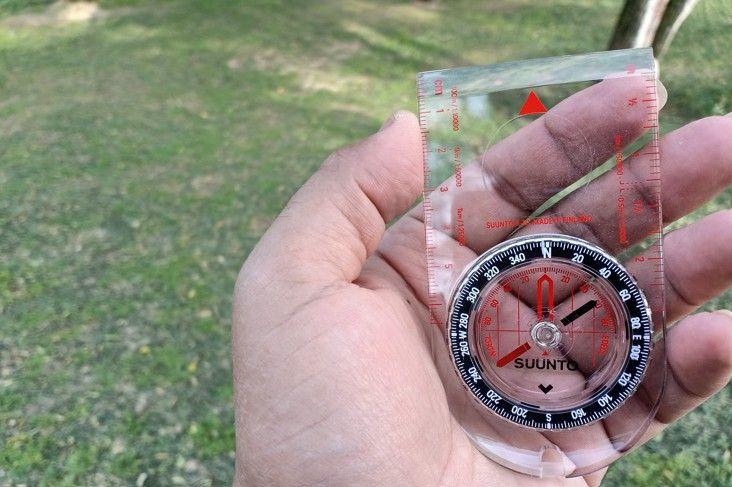
Choose a compass with clear writing. Cluttered details hinder decision-making, which leads to unintended detours.
Beginners can also benefit from bezels with numbers and plain baseplates. Put simply, the compass must be handy to use and highly efficient in its work.
Accuracy and Precision
Another highly acclaimed feature of a compass is its accuracy and precision. Normally, the initial versions of compasses are least accurate compared to the professional versions.
Let’s say, for example, the SUUNTO A-10 has at least 2 degrees of variation compared to its pro version, the SUUNTO MC-2. Accuracy and precision might not impact the beginners; it matters to the avid hikers and professional explorers.

For better accuracy, mirrored models are highly advisable. Make sure that the needle deepens quickly to avoid oscillations that lead to errors.
Adjustable Declination
This feature helps understand the magnetic north accurately. Declination adjusts the slightest difference between magnetic north and true north.
Compasses have zero errors, which lead to misdirection. Hikers have to do manual math to adjust errors. Declination reduces this error to avoid manual math.
Clinometer
A clinometer helps a hiker to understand the slope of a terrain. This feature is critical to predicting the possibility of an avalanche in any terrain.
This feature also helps in planning climbing and making it easy. You cannot expect this feature in beginner versions, as this is a professional feature that unfolds only with pro versions like SUUNTO MC-2.
Price
Depending on the features and ease of use, prices of compasses vary. Initial versions have a lesser price compared to pro versions.
From $10 for beginners, it may go up to $100 based on the user’s experience. Make sure to invest in the features that are robust for technical hikes. For casual use, cheaper models do absolutely fine.
How to Use a Compass
Compasses are handy to use if a person knows the basics. Understanding the features helps a person to align them and check for specific information at the right time. Follow the following steps to understand the use precisely:
- Orientation of the map: Align the compass on the map and set the directions right.
- Set declination: Adjust this feature as per the magnetic variation. At times, you don’t need to adjust declination due to zero variance.
- Take a bearing: After adjusting variance, set the direction-of-travel needle to the target. Now, rotate the bezel until the needle aligns with the orienting arrow.
- Keep following the lead of bearing: Make sure to keep the needle aligned to the orienting arrow as you travel.
Put simply, hold the compass flat in your hand and align the direction-of-travel arrow with your intended path. Now rotate the bezel until the magnetic needle and north arrow align.
Keep the direction indicated by the arrow and start your journey. Now, for the map navigation, place the baseplate on the map and adjust your directions accordingly. You can use sighting mirror for long-distance navigation.
Conclusion
Compasses are the all-weather companion for a hiker. Beyond 5G and any modern device, these small analog devices guide hikers and adventurers in the right direction. For beginners, some very affordable and simple models like the four-function Whistle compass and SUUNTO A-10 do the necessary work.
If you are a professional hiker, you need a more complex and accurate compass like the SUUNTO MC-2 and Ranger 2.0. These compasses offer a far better and more accurate measurement of the distance and direction.
Some important features like a clinometer and adjustable declination make them stand out from the normal compasses. In conclusion, get expert advice before buying a compass and make sure that your compass caters to the needs of your hiking.
FAQs
What Type of Compass is Best for hiking?
Baseplate compasses are best for hiking. These compasses offer map compatibility and portability; some famous examples are SUUNTO M-3 NH, Silva Ranger 2.0, and Brunton TruArc 3. Furthermore, mirrored models are also excellent for hiking as they provide precision and accuracy alongside technical routes. Mirror models like Suunto MC-2G Global, Silva Ranger 515 CL, and Brunton 9077 Eclipse are preferable choices.
What is the Most Accurate Compass?
SUUNTO MC-2 and Ranger 2.0 are considered the most accurate and top contenders. These models feature global needles, adjustable declination, and mirrored sighting. All these features are considered the most professional tools for a compass.
What is the Best Baseplate Compass for Hiking?
It is difficult to name a compass as the best for hiking. The recommendation always rests with the hiker’s choices and needs. SUUNTO A-10 is considered the most reliable compass with no frills. SUUNTO MC-3 has declination adjustment, and Ranger 2.0 offers a clinometer, which offers advanced slope measurement.
